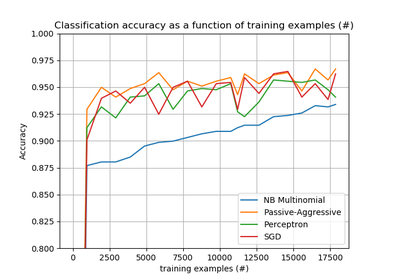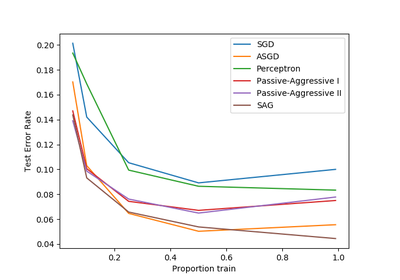sklearn.linear_model.Perceptron¶
-
class
sklearn.linear_model.Perceptron(penalty=None, alpha=0.0001, fit_intercept=True, max_iter=None, tol=None, shuffle=True, verbose=0, eta0=1.0, n_jobs=1, random_state=0, class_weight=None, warm_start=False, n_iter=None)[source]¶ Read more in the User Guide.
Parameters: penalty : None, ‘l2’ or ‘l1’ or ‘elasticnet’
The penalty (aka regularization term) to be used. Defaults to None.
alpha : float
Constant that multiplies the regularization term if regularization is used. Defaults to 0.0001
fit_intercept : bool
Whether the intercept should be estimated or not. If False, the data is assumed to be already centered. Defaults to True.
max_iter : int, optional
The maximum number of passes over the training data (aka epochs). It only impacts the behavior in the
fitmethod, and not the partial_fit. Defaults to 5. Defaults to 1000 from 0.21, or if tol is not None.New in version 0.19.
tol : float or None, optional
The stopping criterion. If it is not None, the iterations will stop when (loss > previous_loss - tol). Defaults to None. Defaults to 1e-3 from 0.21.
New in version 0.19.
shuffle : bool, optional, default True
Whether or not the training data should be shuffled after each epoch.
verbose : integer, optional
The verbosity level
eta0 : double
Constant by which the updates are multiplied. Defaults to 1.
n_jobs : integer, optional
The number of CPUs to use to do the OVA (One Versus All, for multi-class problems) computation. -1 means ‘all CPUs’. Defaults to 1.
random_state : int, RandomState instance or None, optional, default None
The seed of the pseudo random number generator to use when shuffling the data. If int, random_state is the seed used by the random number generator; If RandomState instance, random_state is the random number generator; If None, the random number generator is the RandomState instance used by np.random.
class_weight : dict, {class_label: weight} or “balanced” or None, optional
Preset for the class_weight fit parameter.
Weights associated with classes. If not given, all classes are supposed to have weight one.
The “balanced” mode uses the values of y to automatically adjust weights inversely proportional to class frequencies in the input data as
n_samples / (n_classes * np.bincount(y))warm_start : bool, optional
When set to True, reuse the solution of the previous call to fit as initialization, otherwise, just erase the previous solution.
n_iter : int, optional
The number of passes over the training data (aka epochs). Defaults to None. Deprecated, will be removed in 0.21.
Changed in version 0.19: Deprecated
Attributes: coef_ : array, shape = [1, n_features] if n_classes == 2 else [n_classes, n_features]
Weights assigned to the features.
intercept_ : array, shape = [1] if n_classes == 2 else [n_classes]
Constants in decision function.
n_iter_ : int
The actual number of iterations to reach the stopping criterion. For multiclass fits, it is the maximum over every binary fit.
See also
Notes
Perceptron and SGDClassifier share the same underlying implementation. In fact, Perceptron() is equivalent to SGDClassifier(loss=”perceptron”, eta0=1, learning_rate=”constant”, penalty=None).
References
https://en.wikipedia.org/wiki/Perceptron and references therein.
Methods
decision_function(X)Predict confidence scores for samples. densify()Convert coefficient matrix to dense array format. fit(X, y[, coef_init, intercept_init, …])Fit linear model with Stochastic Gradient Descent. get_params([deep])Get parameters for this estimator. partial_fit(X, y[, classes, sample_weight])Fit linear model with Stochastic Gradient Descent. predict(X)Predict class labels for samples in X. score(X, y[, sample_weight])Returns the mean accuracy on the given test data and labels. set_params(*args, **kwargs)sparsify()Convert coefficient matrix to sparse format. -
__init__(penalty=None, alpha=0.0001, fit_intercept=True, max_iter=None, tol=None, shuffle=True, verbose=0, eta0=1.0, n_jobs=1, random_state=0, class_weight=None, warm_start=False, n_iter=None)[source]¶
-
decision_function(X)[source]¶ Predict confidence scores for samples.
The confidence score for a sample is the signed distance of that sample to the hyperplane.
Parameters: X : {array-like, sparse matrix}, shape = (n_samples, n_features)
Samples.
Returns: array, shape=(n_samples,) if n_classes == 2 else (n_samples, n_classes) :
Confidence scores per (sample, class) combination. In the binary case, confidence score for self.classes_[1] where >0 means this class would be predicted.
-
densify()[source]¶ Convert coefficient matrix to dense array format.
Converts the
coef_member (back) to a numpy.ndarray. This is the default format ofcoef_and is required for fitting, so calling this method is only required on models that have previously been sparsified; otherwise, it is a no-op.Returns: self : estimator
-
fit(X, y, coef_init=None, intercept_init=None, sample_weight=None)[source]¶ Fit linear model with Stochastic Gradient Descent.
Parameters: X : {array-like, sparse matrix}, shape (n_samples, n_features)
Training data
y : numpy array, shape (n_samples,)
Target values
coef_init : array, shape (n_classes, n_features)
The initial coefficients to warm-start the optimization.
intercept_init : array, shape (n_classes,)
The initial intercept to warm-start the optimization.
sample_weight : array-like, shape (n_samples,), optional
Weights applied to individual samples. If not provided, uniform weights are assumed. These weights will be multiplied with class_weight (passed through the constructor) if class_weight is specified
Returns: self : returns an instance of self.
-
get_params(deep=True)[source]¶ Get parameters for this estimator.
Parameters: deep : boolean, optional
If True, will return the parameters for this estimator and contained subobjects that are estimators.
Returns: params : mapping of string to any
Parameter names mapped to their values.
-
loss_function¶ DEPRECATED: Attribute loss_function was deprecated in version 0.19 and will be removed in 0.21. Use
loss_function_instead
-
partial_fit(X, y, classes=None, sample_weight=None)[source]¶ Fit linear model with Stochastic Gradient Descent.
Parameters: X : {array-like, sparse matrix}, shape (n_samples, n_features)
Subset of the training data
y : numpy array, shape (n_samples,)
Subset of the target values
classes : array, shape (n_classes,)
Classes across all calls to partial_fit. Can be obtained by via np.unique(y_all), where y_all is the target vector of the entire dataset. This argument is required for the first call to partial_fit and can be omitted in the subsequent calls. Note that y doesn’t need to contain all labels in classes.
sample_weight : array-like, shape (n_samples,), optional
Weights applied to individual samples. If not provided, uniform weights are assumed.
Returns: self : returns an instance of self.
-
predict(X)[source]¶ Predict class labels for samples in X.
Parameters: X : {array-like, sparse matrix}, shape = [n_samples, n_features]
Samples.
Returns: C : array, shape = [n_samples]
Predicted class label per sample.
-
score(X, y, sample_weight=None)[source]¶ Returns the mean accuracy on the given test data and labels.
In multi-label classification, this is the subset accuracy which is a harsh metric since you require for each sample that each label set be correctly predicted.
Parameters: X : array-like, shape = (n_samples, n_features)
Test samples.
y : array-like, shape = (n_samples) or (n_samples, n_outputs)
True labels for X.
sample_weight : array-like, shape = [n_samples], optional
Sample weights.
Returns: score : float
Mean accuracy of self.predict(X) wrt. y.
-
sparsify()[source]¶ Convert coefficient matrix to sparse format.
Converts the
coef_member to a scipy.sparse matrix, which for L1-regularized models can be much more memory- and storage-efficient than the usual numpy.ndarray representation.The
intercept_member is not converted.Returns: self : estimator Notes
For non-sparse models, i.e. when there are not many zeros in
coef_, this may actually increase memory usage, so use this method with care. A rule of thumb is that the number of zero elements, which can be computed with(coef_ == 0).sum(), must be more than 50% for this to provide significant benefits.After calling this method, further fitting with the partial_fit method (if any) will not work until you call densify.
-




